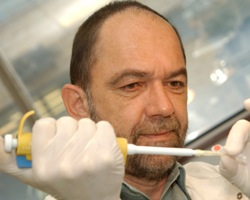Professor Sir Alec John Jeffreys

- Born
- 9 January 1950
Professor Sir Alec Jeffreys FSB is a British geneticist who discovered the technique that was to be known as DNA fingerprinting, now an invaluable tool in forensic science.
Jeffreys was born in Oxford in 1950. His parents moved to Luton when he was six years old and that is where he grew up. On his eighth birthday his father gave him a chemistry set which the young Jeffreys enhanced with the addition of extra chemicals such as concentrated sulphuric acid, bought from local the pharmacy. He enjoyed making explosions with the set and this resulted in a scar on his chin which he now covers with a beard.
Jeffreys went back to Oxford for university, where he read Biochemistry at Merton College and then studied for a PhD on Studies on the mitochondria of cultured mammalian cells. After his PhD, Jeffreys moved to Amsterdam as a research fellow working on mammalian DNA. His work contributed to the understanding of the structure of mammalian genes and the presence of introns.
My life changed on Monday morning at 9.05 am, 10 September 1984. What emerged was the world's first genetic fingerprint. In science it is unusual to have such a 'eureka' moment. We were getting extraordinarily variable patterns of DNA, including from our technician and her mother and father, as well as from non-human samples. My first reaction to the results was 'this is too complicated', and then the penny dropped and I realised we had genetic fingerprinting.
In 1977, Jeffreys moved to the University of Leicester and worked in the same laboratory until he retired in 2012. It was here that, while studying repeated DNA, he had his ‘eureka’ moment on Monday 10th September 1984. He noticed that the result he first thought was “a complete mess” would give him the ability to identify individuals. The technique he had discovered was soon called DNA fingerprinting. The first case this was used in, an immigration case, came in March 1985 closely followed by paternity cases. Alec and his team later perfected the technique and DNA profiling was born in 1985. Since then it has helped to solve numerous immigration, paternity and murder cases and is used extensively in conservation and diversity in non-human species work. Jeffreys also worked with Yuri Dubrova to investigate mutations caused by the Chernobyl disaster.
DNA fingerprinting and genetic profiling are not Jeffrey’s only achievements. His real interest was human genetic variation. His work shed light on the way genetic information is shuffled from one generation to the next and he discovered that there are regions in the human genome, the so called recombination ’hotspots’ that show very high level of change between generations. This part of his work later led to the development of the International HapMap project to which scientists from all over the world contributed. This has allowed the extensive mapping of genetic diversity across the whole human genome.
Jeffreys became an honorary freeman of the City of Leicester in 1992 and was knighted for his services to science and technology in 1994. He also received various awards including the Copley Medal which is one of the world’s oldest scientific awards.
This profile was written by a Biology: Changing the World volunteer.



